Stefano Savazzi
Device-Free Localization with Multiple Antenna Receivers: Simulations and Results
Jun 09, 2025Abstract:Device-Free Localization (DFL) is a passive radio method able to detect, estimate, and localize targets (e.g., human or other obstacles) that do not need to carry any electronic device. According to the Integrated Sensing And Communication (ISAC) paradigm, DFL networks exploit Radio Frequency (RF) devices, used for communication purposes, to evaluate also the excess attenuation due to targets moving in the monitored area, to estimate the target positions and movements. Several target models have been discussed in the literature to evaluate the target positions by exploiting the RF signals received by networked devices. Among these models, Electromagnetic (EM) body models emerged as an interesting research field for excess attenuation prediction using commercial RF devices. While these RF devices are usually single-antenna boards, the availability of low-cost multi-antenna devices e.g. those used in WLAN (Wireless Local Area Network) scenarios, allow us to exploit array-based signal processing techniques for DFL applications as well. Using an array-capable EM body model, this paper shows how to employ array-based processing to improve angular detection of targets. Unlike single-antenna devices that can provide only attenuation information, multi-antenna devices can provide both angular and attenuation estimates about the target location. To this end, simulations are presented and preliminary results are discussed. The proposed framework paves the way for a wider use of multi-antenna devices based, for instance, on WiFi6 and WiFi7 standards.
Bayesian Federated Learning for Continual Training
Apr 21, 2025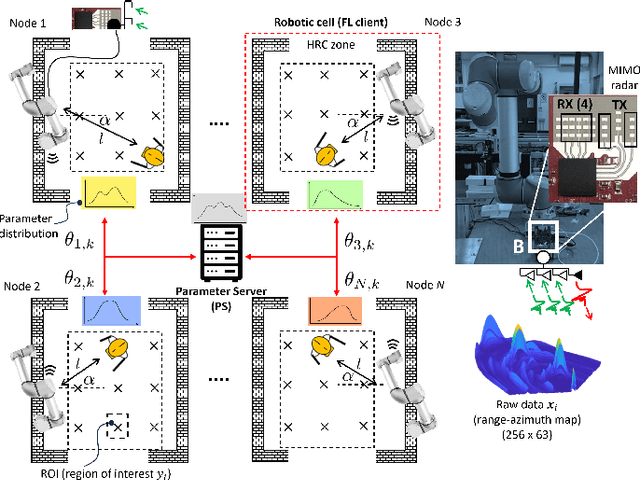
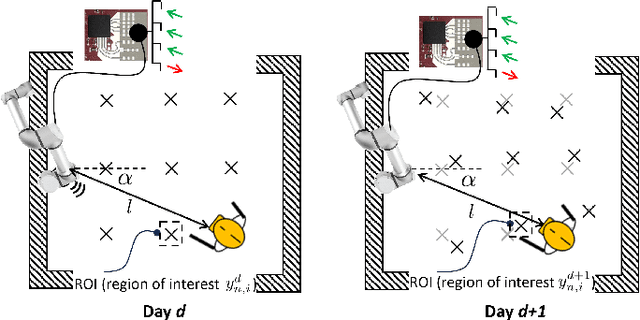
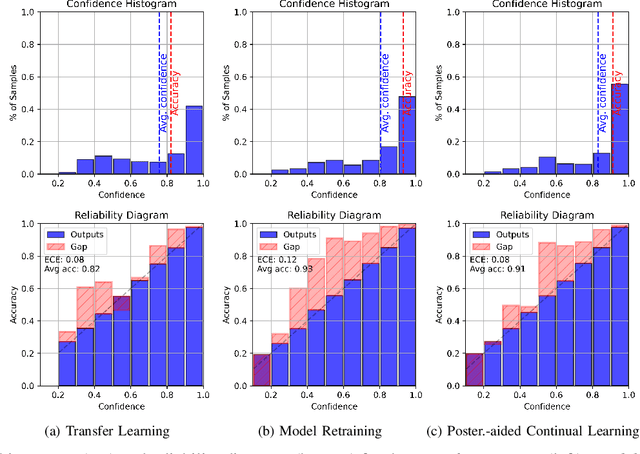
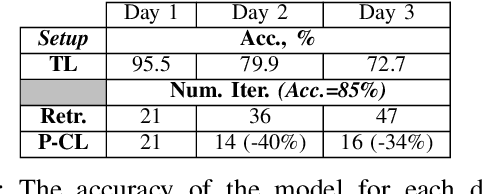
Abstract:Bayesian Federated Learning (BFL) enables uncertainty quantification and robust adaptation in distributed learning. In contrast to the frequentist approach, it estimates the posterior distribution of a global model, offering insights into model reliability. However, current BFL methods neglect continual learning challenges in dynamic environments where data distributions shift over time. We propose a continual BFL framework applied to human sensing with radar data collected over several days. Using Stochastic Gradient Langevin Dynamics (SGLD), our approach sequentially updates the model, leveraging past posteriors to construct the prior for the new tasks. We assess the accuracy, the expected calibration error (ECE) and the convergence speed of our approach against several baselines. Results highlight the effectiveness of continual Bayesian updates in preserving knowledge and adapting to evolving data.
Full-wave EM simulation analysis of human body blockage by dense 2D antenna arrays
May 15, 2024Abstract:Recently, proposals of human-sensing-based services for cellular and local area networks have brought indoor localization to the attention of several research groups. In response to these stimuli, various Device-Free Localization (DFL) techniques, also known as Passive Localization methods, have emerged by exploiting ambient signals to locate and track individuals that do not carry any electronic device. This study delves into human passive indoor localization through full-wave electromagnetic simulations. For the scope, we exploit simulations from the commercial tool FEKO software that employs the Method of Moments (MoM). In particular, we collect and analyze the electric field values in a scenario constituted by a dense 2D/3D deployment of receivers in the presence of an anthropomorphic mobile target. The paper describes in detail the collected dataset and provides a first analysis based on a statistical approach. Possible use cases are also investigated through examples in the context of passive localization, sensing, and imaging.
On the impact of the antenna radiation patterns in passive radio sensing
May 15, 2024Abstract:Electromagnetic (EM) body models based on the scalar diffraction theory allow to predict the impact of subject motions on the radio propagation channel without requiring a time-consuming full-wave approach. On the other hand, they are less effective in complex environments characterized by significant multipath effects. Recently, emerging radio sensing applications have proposed the adoption of smart antennas with non-isotropic radiation characteristics to improve coverage.This letter investigates the impact of antenna radiation patterns in passive radio sensing applications. Adaptations of diffraction-based EM models are proposed to account for antenna non-uniform angular filtering. Next, we quantify experimentally the impact of diffraction and multipath disturbance components on radio sensing accuracy in environments with smart antennas.
Compressed Bayesian Federated Learning for Reliable Passive Radio Sensing in Industrial IoT
May 09, 2024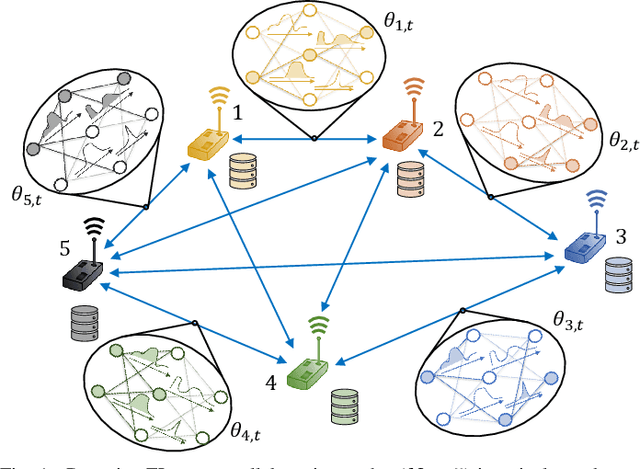
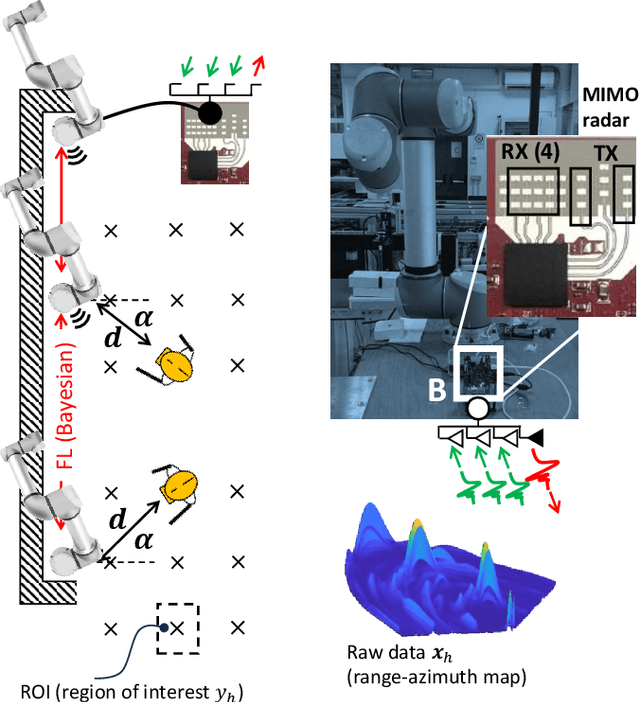
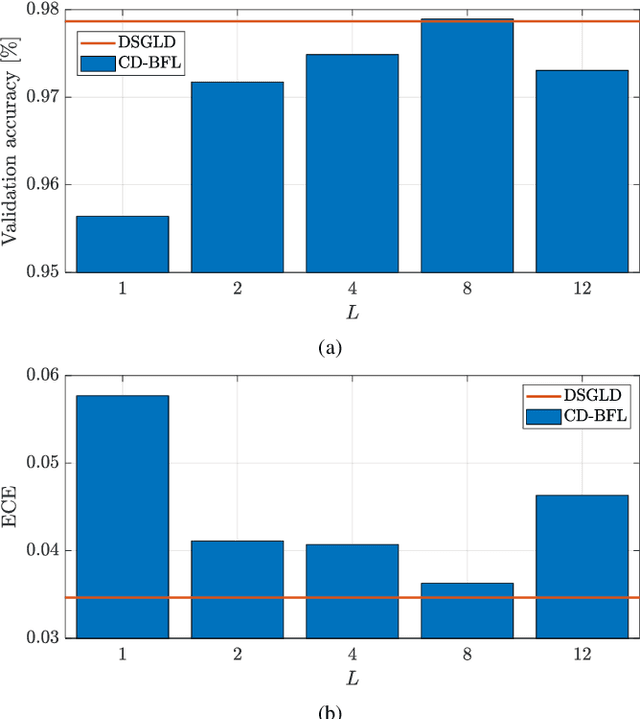
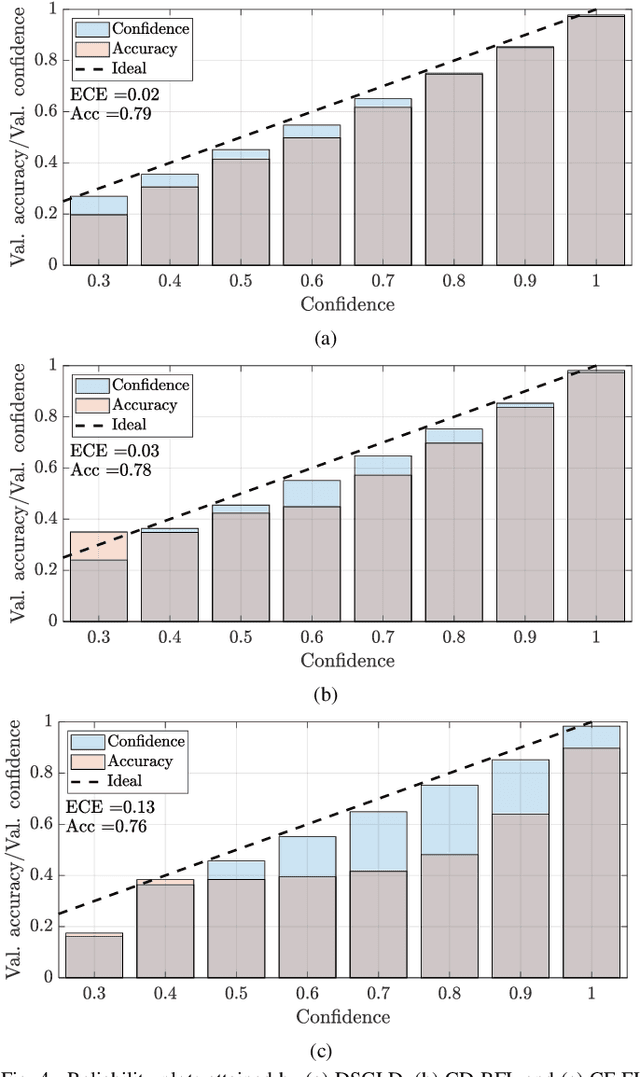
Abstract:Bayesian Federated Learning (FL) has been recently introduced to provide well-calibrated Machine Learning (ML) models quantifying the uncertainty of their predictions. Despite their advantages compared to frequentist FL setups, Bayesian FL tools implemented over decentralized networks are subject to high communication costs due to the iterated exchange of local posterior distributions among cooperating devices. Therefore, this paper proposes a communication-efficient decentralized Bayesian FL policy to reduce the communication overhead without sacrificing final learning accuracy and calibration. The proposed method integrates compression policies and allows devices to perform multiple optimization steps before sending the local posterior distributions. We integrate the developed tool in an Industrial Internet of Things (IIoT) use case where collaborating nodes equipped with autonomous radar sensors are tasked to reliably localize human operators in a workplace shared with robots. Numerical results show that the developed approach obtains highly accurate yet well-calibrated ML models compatible with the ones provided by conventional (uncompressed) Bayesian FL tools while substantially decreasing the communication overhead (i.e., up to 99%). Furthermore, the proposed approach is advantageous when compared with state-of-the-art compressed frequentist FL setups in terms of calibration, especially when the statistical distribution of the testing dataset changes.
Physics-informed generative neural networks for RF propagation prediction with application to indoor body perception
May 03, 2024Abstract:Electromagnetic (EM) body models designed to predict Radio-Frequency (RF) propagation are time-consuming methods which prevent their adoption in strict real-time computational imaging problems, such as human body localization and sensing. Physics-informed Generative Neural Network (GNN) models have been recently proposed to reproduce EM effects, namely to simulate or reconstruct missing data or samples by incorporating relevant EM principles and constraints. The paper discusses a Variational Auto-Encoder (VAE) model which is trained to reproduce the effects of human motions on the EM field and incorporate EM body diffraction principles. Proposed physics-informed generative neural network models are verified against both classical diffraction-based EM tools and full-wave EM body simulations.
An EM Body Model for Device-Free Localization with Multiple Antenna Receivers: A First Study
May 02, 2024Abstract:Device-Free Localization (DFL) employs passive radio techniques capable to detect and locate people without imposing them to wear any electronic device. By exploiting the Integrated Sensing and Communication paradigm, DFL networks employ Radio Frequency (RF) nodes to measure the excess attenuation introduced by the subjects (i.e., human bodies) moving inside the monitored area, and to estimate their positions and movements. Physical, statistical, and ElectroMagnetic (EM) models have been proposed in the literature to estimate the body positions according to the RF signals collected by the nodes. These body models usually employ a single-antenna processing for localization purposes. However, the availability of low-cost multi-antenna devices such as those used for WLAN (Wireless Local Area Network) applications and the timely development of array-based body models, allow us to employ array-based processing techniques in DFL networks. By exploiting a suitable array-capable EM body model, this paper proposes an array-based framework to improve people sensing and localization. In particular, some simulations are proposed and discussed to compare the model results in both single- and multi-antenna scenarios. The proposed framework paves the way for a wider use of multi-antenna devices (e.g., those employed in current IEEE 802.11ac/ax/be and forthcoming IEEE 802.11be networks) and novel beamforming algorithms for DFL scenarios.
On the Impact of Data Heterogeneity in Federated Learning Environments with Application to Healthcare Networks
May 01, 2024



Abstract:Federated Learning (FL) allows multiple privacy-sensitive applications to leverage their dataset for a global model construction without any disclosure of the information. One of those domains is healthcare, where groups of silos collaborate in order to generate a global predictor with improved accuracy and generalization. However, the inherent challenge lies in the high heterogeneity of medical data, necessitating sophisticated techniques for assessment and compensation. This paper presents a comprehensive exploration of the mathematical formalization and taxonomy of heterogeneity within FL environments, focusing on the intricacies of medical data. In particular, we address the evaluation and comparison of the most popular FL algorithms with respect to their ability to cope with quantity-based, feature and label distribution-based heterogeneity. The goal is to provide a quantitative evaluation of the impact of data heterogeneity in FL systems for healthcare networks as well as a guideline on FL algorithm selection. Our research extends beyond existing studies by benchmarking seven of the most common FL algorithms against the unique challenges posed by medical data use cases. The paper targets the prediction of the risk of stroke recurrence through a set of tabular clinical reports collected by different federated hospital silos: data heterogeneity frequently encountered in this scenario and its impact on FL performance are discussed.
A Secure and Trustworthy Network Architecture for Federated Learning Healthcare Applications
Apr 17, 2024



Abstract:Federated Learning (FL) has emerged as a promising approach for privacy-preserving machine learning, particularly in sensitive domains such as healthcare. In this context, the TRUSTroke project aims to leverage FL to assist clinicians in ischemic stroke prediction. This paper provides an overview of the TRUSTroke FL network infrastructure. The proposed architecture adopts a client-server model with a central Parameter Server (PS). We introduce a Docker-based design for the client nodes, offering a flexible solution for implementing FL processes in clinical settings. The impact of different communication protocols (HTTP or MQTT) on FL network operation is analyzed, with MQTT selected for its suitability in FL scenarios. A control plane to support the main operations required by FL processes is also proposed. The paper concludes with an analysis of security aspects of the FL architecture, addressing potential threats and proposing mitigation strategies to increase the trustworthiness level.
A Carbon Tracking Model for Federated Learning: Impact of Quantization and Sparsification
Oct 12, 2023



Abstract:Federated Learning (FL) methods adopt efficient communication technologies to distribute machine learning tasks across edge devices, reducing the overhead in terms of data storage and computational complexity compared to centralized solutions. Rather than moving large data volumes from producers (sensors, machines) to energy-hungry data centers, raising environmental concerns due to resource demands, FL provides an alternative solution to mitigate the energy demands of several learning tasks while enabling new Artificial Intelligence of Things (AIoT) applications. This paper proposes a framework for real-time monitoring of the energy and carbon footprint impacts of FL systems. The carbon tracking tool is evaluated for consensus (fully decentralized) and classical FL policies. For the first time, we present a quantitative evaluation of different computationally and communication efficient FL methods from the perspectives of energy consumption and carbon equivalent emissions, suggesting also general guidelines for energy-efficient design. Results indicate that consensus-driven FL implementations should be preferred for limiting carbon emissions when the energy efficiency of the communication is low (i.e., < 25 Kbit/Joule). Besides, quantization and sparsification operations are shown to strike a balance between learning performances and energy consumption, leading to sustainable FL designs.
 Add to Chrome
Add to Chrome Add to Firefox
Add to Firefox Add to Edge
Add to Edge